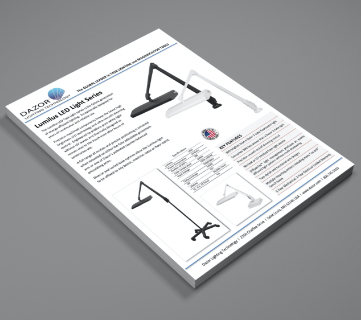Lighting Terminology
Light:
Light is subdivided by different wavelengths into colors. Light with the shortest wavelength, close to ultra violet, we call violet. Then, in increasing wavelengths, come blue green, yellow, orange, and ending at with red. Light is changed by addition such that white light results from the proper mixture of red, green, and blue.
Lamp:
As used in the industry, does not mean that thing on your end table with the shade on it; it refers to a light bulb or tube. "Table," "floor," "task," or "portable" are added to indicate the apparatus containing a light bulb.
Luminaire:
A housing or fixture that holds a light source (lamp).
Lumens:
The light output from a lamp (bulb or tube) is expressed in lumens. A 100-watt incandescent bulb produces 1750 lumens; a 40-watt cool white fluorescent produces 3150 lumens. Lumens can be thought of as the measurement for the flow rate of light.
The efficiency of light sources is measured by the amount of light emitted for each watt of power used, or lumens per watt. In the above example, a 100-watt incandescent has 17.5 lumens per watt while the 40-watt fluorescent has 78.75 lumens per watt.
Footcandle:
When one lumen of light falls of a 1-square-foot surface, the resultant illumination level is one foot candle. One foot-candle equals one lumen per square foot.
Foot-candles can be measured with a hand held meter underneath a light source from a fixture to determine how much light reaches the work surface.
Measurement of foot-candles varies depending upon the distance the meter is from the light source.
Kelvin Scale:
Apparent color temperature of a light source indicates its degree of blueness or redness as we view it. The higher the number, the bluer the light appears; the lower the number, the more red the light looks. A candle flame has an apparent color temperature of about 1800 degrees Kelvin, incandescent lamps are about 2900K, cool white fluorescent are about 4200K and an overcast sky appears about 6500K. The Kelvin scale gives no indication about color rendering. It does not tell you how accurately colors will appear under a particular light source.
Color Rendering Index:
A rating scale for light sources (lamps) from 0 to 100 to indicate how accurately colors can be perceived under a light source. The higher the CRI, the more accurately colors appear. Technically, CRI ratings should only be compared for lamps with similar color temperatures (Kelvin ratings).
Full Spectrum Bulbs:
Manufacturers of these bulbs claim that they produce light wavelengths from across the "full spectrum" thus blending all wavelengths to produce "daylight" like natural sunlight which contains all wavelengths. Typically, a bulb is classified as "full spectrum" when it has a CRI above 90 and a Kelvin temperature around 5500K.




